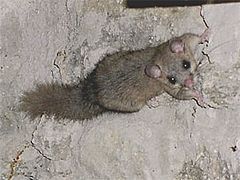Glirinae facts for kids
Quick facts for kids Glirinae |
|
|---|---|
 |
|
| Glis glis | |
| Scientific classification | |
| Kingdom: | |
| Phylum: | |
| Class: | |
| Order: | |
| Family: | |
| Subfamily: |
Glirinae
Muirhead, 1819
|
| Genera | |
Glirinae is a special group, or subfamily, of small, furry creatures called dormice. These animals are part of the larger dormouse family known as Gliridae. Think of it like a branch on a family tree!
This subfamily includes two main types of dormice that are still alive today: the Glirulus and the Glis. Each of these types, or genera, has only one known species. These are the fascinating Glirulus japonicus, also known as the Japanese dormouse, and the Glis glis, which is commonly called the edible dormouse.
Contents
Meet the Glirinae Dormice
The Glirinae subfamily is home to some unique dormice. They are known for their small size and often their long, bushy tails. These animals are mostly active at night, which means they are nocturnal. They spend their days sleeping soundly in cozy nests.
The Japanese Dormouse
The Glirulus japonicus is a tiny dormouse found only in Japan. It's one of the smallest dormice in the world! This little mammal lives in forests, often in mountainous areas. It's known for its agility, moving quickly through trees.
What the Japanese Dormouse Looks Like
The Japanese dormouse has soft, brownish-grey fur on its back. Its belly is usually white or cream-colored. It has large, dark eyes and small, rounded ears. A distinctive feature is a dark stripe that runs from its nose to its ears. Its tail is long and bushy, helping it balance as it climbs.
Where They Live
These dormice prefer to live in deciduous and coniferous forests. They are often found in the trees, making their homes in tree hollows or old bird nests. Sometimes, they might even build their own nests using leaves and moss.
Their Diet
The Japanese dormouse mainly eats insects, fruits, seeds, and flower nectar. They are important for spreading seeds and pollinating plants in their forest homes. They are very active foragers, always looking for their next meal.
The Edible Dormouse
The Glis glis is the largest species of dormouse. It is found across much of Europe. Its name, "edible dormouse," comes from ancient Roman times. The Romans used to raise them for food, considering them a delicacy.
Appearance of the Edible Dormouse
The edible dormouse has grey fur on its back and white fur on its underside. It has large, dark eyes with dark rings around them, giving it a masked look. Its ears are small and round. Like other dormice, it has a long, bushy tail, similar to a squirrel's.
Where They Are Found
These dormice live in various habitats, including broadleaf forests, orchards, and even gardens. They are excellent climbers and spend most of their lives in trees. They build nests in tree hollows, rock crevices, or even in attics of houses.
What They Eat
The diet of the edible dormouse is quite varied. They eat fruits, nuts, acorns, and berries. They also consume insects, bird eggs, and even small birds. They are known for their love of hazelnuts and beech nuts.
Hibernation Habits
One of the most famous traits of the edible dormouse is its long hibernation period. They can sleep for up to seven months of the year! They prepare for this long sleep by eating a lot and building up fat reserves. They find a safe, sheltered spot, like a burrow or a tree hollow, to hibernate. During hibernation, their body temperature drops, and their heart rate slows down significantly.
Dormice Life Cycle
Dormice typically mate in the spring or early summer. After a gestation period (pregnancy) of about three to four weeks, the female gives birth to a litter of tiny, helpless pups. A litter usually consists of two to ten young.
Raising the Young
The mother dormouse cares for her young in a carefully built nest. The pups are born blind and without fur. They grow quickly, and their eyes open after about two to three weeks. They are weaned (stop drinking milk) after about a month. The young dormice become independent and leave the nest when they are around two months old. They usually reach sexual maturity by their first year.
Conservation Status
Both the Japanese dormouse and the edible dormouse are generally not considered endangered. However, like many wild animals, their populations can be affected by habitat loss. This happens when forests are cut down or their living areas are disturbed. Protecting their natural homes is important for their survival.

